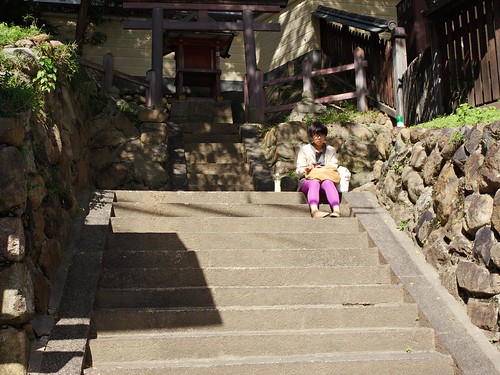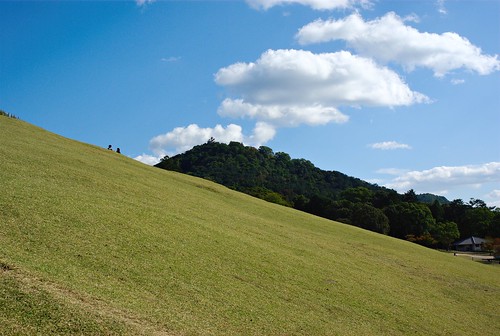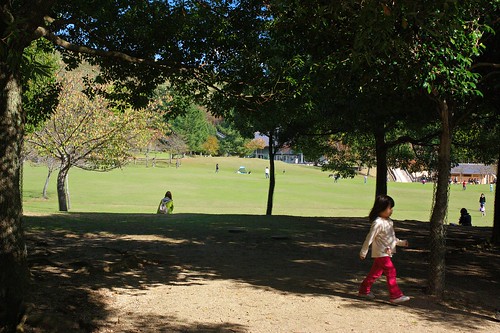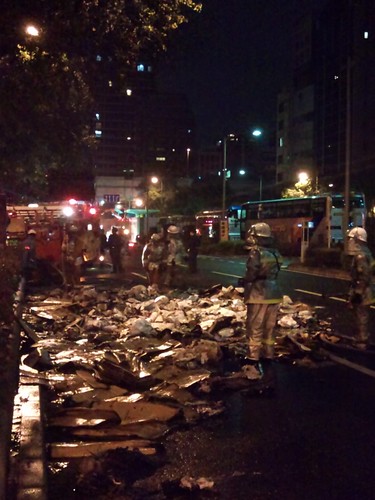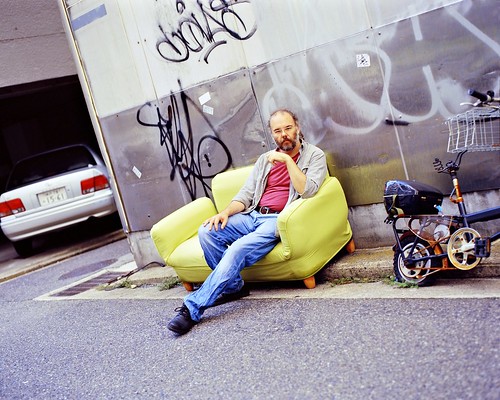Still no end in sight at work. I've spent far too much trying to track down a subtle bug that seems to appear only when I run batch - not individual - simulations on the remote cluster. So instead of wasting time here, jump over to "Twisting Flowers" who has a nice summary post about the state of Japanese agriculture.
In short, the agricultural sector is protected by far more, and far higher tariffs than elsewhere. Farming is completely dominated by elderly farmers - at or above pension age - with very few young people coming into the profession, and almost none who aren't born into a farming family already. The total number of farmers in Japan is about 2% of the population.
Not mentioned there, but I have read elsewhere that about 10% of those counting as farmers never actually farm anything; they have a plot of land (often inherited I guess) and membership in the agricultural association. Sizeable amounts of land lie fallow due to these ghost farmers, and due to a lack of people willing and able to work it.
So when you hear that Japan declines a free trade agreement that would greatly help its industrial (13% of the population) and service sectors (65% of the population) out of consideration for the farmers, realize that they are protecting 2% of the population, the majority of whom are already eligible for a pension anyhow. Also, the agricultural industry has modernized so production cost of staple foods like rice is no longer much higher than elsewhere. Open markets would not destroy farming, though it would forced to modernize and consolidate. But then, as the number of farmers keep dropping this is what's happening already.
And in case you wonder why political parties keep favouring the old and the few over the young and the many, all you need to do is look at voting power disparity. Small, rural districts have several times the voting power of large urban areas. That old farmer really is worth four or five Tokyo company workers, as far as political power is concerned. The courts have declared it illegal several times, but the parties keep ignoring it and the courts are powerless to impose any kind of sanctions.
Eventually, of course, the problem will disappear along with the farmers. As old farmers die out and rural areas depopulate they will eventually no longer wield enough voting clout to dictate terms for the rest of the country. The question is how much damage will be done before this happens.
Tuesday, November 30, 2010
Friday, November 26, 2010
Nara
We go to Kobe once or twice every month. We get to Kyoto at least a few times every year. But for some reason we almost never go to Nara. This despite the fact that Nara is the closest city we have here, closer than any of the others we visit (ok, Sakai and the other cities of Osaka county are even closer, but I can't really see them as separate from Osaka). I even work in Nara county and go most of the way there and back every day. And yet, I've even been to Tokyo more often - I've been to Hokkaido more often, even - than I've been to Nara right next door.
So when we went to Nara a few weeks ago1 it was the first time for us in years. It was a long weekend, and the whole town was packed with tourists. It's not a large city, Nara, nor is it very scenic. Most visitors are drawn there by its history. It was the first real capital of Japan (though for less than a century) and has a very large, very old temple area in the outskirts of town2. Nara historical museum holds a large collection of early national treasures. Our visit coincided with the yearly public exhibition, and that certainly added to the throngs of people; when we passed by the museum, the line was over two hours long.
Nara is a normal town, not just an outdoor museum. If you live here the scenery is all part of your normal environment. Here a student has found himself a warm, sunny spot by some old temple.
The main draw of Nara is Todaiji, a large, old temple with the largest3 Buddha statue in Japan. The surrounding park is filled with free-wandering deer that are not to be hurt in any way, without exception even for a savoury red-wine stew of venison and potatoes with sauteed autumn vegetables. Harsh rule, that. There's no reciprocal rule of not hurting humans either, so parents need to keep an eye on their children lest they get mobbed by aggressive deer looking for snacks.
Wakakusa mountain is actually a large, steep grassy hill; it's quite spectacular in its way. The sunny hillside is pleasantly warm even in autumn and gives you a good view of Nara. Lots of couples seem to climb up here to sit together on the grass and look at the view, and a fair number of people were sliding down the steep hill on plastic mats, or bouncing a ball up the hill, then try to catch it on the way down.
Nara is a pleasant enough day trip. The temple area is pretty cool, and there's a fair amount of beautiful walking paths among the hills nearby. But there's lots more temples and shrines in Kyoto if that's the kind of stuff you're interested in, and the Fushimi Inari shrine between Kyoto and Nara is both more spectacular than the Nara hills for walking, and less crowded too. Nice, but I doubt we'll make a habit of coming here very often.
There's plenty of green spaces where people gather for picnics or playing games. With less people it would be a great place for family outings. Here's a small, determined park visitor, and Ritsuko in the background.
So when we went to Nara a few weeks ago1 it was the first time for us in years. It was a long weekend, and the whole town was packed with tourists. It's not a large city, Nara, nor is it very scenic. Most visitors are drawn there by its history. It was the first real capital of Japan (though for less than a century) and has a very large, very old temple area in the outskirts of town2. Nara historical museum holds a large collection of early national treasures. Our visit coincided with the yearly public exhibition, and that certainly added to the throngs of people; when we passed by the museum, the line was over two hours long.
Nara is a normal town, not just an outdoor museum. If you live here the scenery is all part of your normal environment. Here a student has found himself a warm, sunny spot by some old temple.
The main draw of Nara is Todaiji, a large, old temple with the largest3 Buddha statue in Japan. The surrounding park is filled with free-wandering deer that are not to be hurt in any way, without exception even for a savoury red-wine stew of venison and potatoes with sauteed autumn vegetables. Harsh rule, that. There's no reciprocal rule of not hurting humans either, so parents need to keep an eye on their children lest they get mobbed by aggressive deer looking for snacks.
Wakakusa mountain is actually a large, steep grassy hill; it's quite spectacular in its way. The sunny hillside is pleasantly warm even in autumn and gives you a good view of Nara. Lots of couples seem to climb up here to sit together on the grass and look at the view, and a fair number of people were sliding down the steep hill on plastic mats, or bouncing a ball up the hill, then try to catch it on the way down.
Nara is a pleasant enough day trip. The temple area is pretty cool, and there's a fair amount of beautiful walking paths among the hills nearby. But there's lots more temples and shrines in Kyoto if that's the kind of stuff you're interested in, and the Fushimi Inari shrine between Kyoto and Nara is both more spectacular than the Nara hills for walking, and less crowded too. Nice, but I doubt we'll make a habit of coming here very often.
There's plenty of green spaces where people gather for picnics or playing games. With less people it would be a great place for family outings. Here's a small, determined park visitor, and Ritsuko in the background.
#1 Yes, this post is weeks late, I know. I have posts planned that should have gone up months ago. I'm very behind with work, and it's not going to improve anytime soon.
#2 It was the sheer number of temples in Nara that cut short its time as capital: the throngs of priests were so intent on playing politics that the then emperor finally simply gave up and moved house, and forbade any of the temples from following him, on pain of, well, pain I assume. The emperor left and the temples stayed behind, to the delight of modern-day Nara.
#3 Well, it's the largest statue when you ask people in Todaiji. If you go to Kamakura southwest of Tokyo they'll tell you that their Buddha is the largest. I know better than to get into a religious dispute so let's just say they're both really, impressively big and leave it at that. The Todaiji one looks cooler, though.
Saturday, November 20, 2010
World Press Photo and Burning Trash
We've gone to the World Press Photo exhibition every year for a few years now. I couldn't make it to the exhibition in Osaka this summer - work kept me too busy - but it's a travelling exhibition so we caught it this weekend at the Ritsumeikan university exhibition hall in Kusatsu east of Kyoto.
It was good; overall I found it to be better than last year. The quality was more even, but I didn't really find any images that popped out and stood out above the rest. This was most obvious in the portrait section, which last year was much more interesting than now. It's almost as if the jury had gotten a lot of heat for its previous eclectic and none-too-flattering portrait selection and got a bit gun-shy this time around.
There were more graphic and violent images this time around - one sequence showing a stoning is pretty disturbing - but that may simply be a reflection of more truly distressing events this year than before. And none of the images strike me as exploitative or speculative; they really are well chosen as documentary images. It's been a good exhibition every year so far, and I can recommend you catch it if it comes to your area.
What's left of the trash heap after the fire and the fire brigade was through with it. Didn't get a shot of the fire itself; they didn't let people out on the street, and I wasn't too keen of going out in that smoke anyhow.
In other, not-very-notable news, a trash dumpster caught fire on the street outside last night. The trash collection round happens after midnight here, and apparently a dumpster truck had a fire start in its cargo just as it was passing by. The driver quite sensibly dumped the entire load on the street before the truck itself caught fire. So we had a quite large, very smelly pile of burning trash and a dozen firemen blocking the entire main road outside and sending the resulting smoke up into the building ventilation system. A smoke that, remember, was caused by rotting leftovers, soggy plastic and pet poo set ablaze. Imagine a cool, fresh early dawn in a dew-sprinkled pine forest, just as the summer sun is drying up the moisture. Then imagine the polar opposite. Makes you appreciate just how much worse Osaka air could be.
It was good; overall I found it to be better than last year. The quality was more even, but I didn't really find any images that popped out and stood out above the rest. This was most obvious in the portrait section, which last year was much more interesting than now. It's almost as if the jury had gotten a lot of heat for its previous eclectic and none-too-flattering portrait selection and got a bit gun-shy this time around.
There were more graphic and violent images this time around - one sequence showing a stoning is pretty disturbing - but that may simply be a reflection of more truly distressing events this year than before. And none of the images strike me as exploitative or speculative; they really are well chosen as documentary images. It's been a good exhibition every year so far, and I can recommend you catch it if it comes to your area.
What's left of the trash heap after the fire and the fire brigade was through with it. Didn't get a shot of the fire itself; they didn't let people out on the street, and I wasn't too keen of going out in that smoke anyhow.
In other, not-very-notable news, a trash dumpster caught fire on the street outside last night. The trash collection round happens after midnight here, and apparently a dumpster truck had a fire start in its cargo just as it was passing by. The driver quite sensibly dumped the entire load on the street before the truck itself caught fire. So we had a quite large, very smelly pile of burning trash and a dozen firemen blocking the entire main road outside and sending the resulting smoke up into the building ventilation system. A smoke that, remember, was caused by rotting leftovers, soggy plastic and pet poo set ablaze. Imagine a cool, fresh early dawn in a dew-sprinkled pine forest, just as the summer sun is drying up the moisture. Then imagine the polar opposite. Makes you appreciate just how much worse Osaka air could be.
Wednesday, November 17, 2010
Cold
It really, really sucks to sort-of have a cold. I mean, at least a real, proper cold or an influenza is unambiguous: you have it or you don't. If you have it you're sick and you're not going to do anything but feel sorry for yourself until you get better.
But a sort-of cold isn't a proper disease. You feel sluggish and tired, and your throat is just painful enough to be annoying. But you're not really sick; you can still go about your day, you can still get things done. Of course, just because you can do stuff it doesn't mean it gets done quickly or well.
I've been under the weather for a couple of days now, and today it's evolved into this dreaded sort-of cold. I've dragged my sorry behind around work all day with my head feeling like its filled with cotton wool. With my luck this'll probably linger on into next week, never really erupting into a proper illness, but not going away either.
Seems it's going to be one of those winters.
But a sort-of cold isn't a proper disease. You feel sluggish and tired, and your throat is just painful enough to be annoying. But you're not really sick; you can still go about your day, you can still get things done. Of course, just because you can do stuff it doesn't mean it gets done quickly or well.
I've been under the weather for a couple of days now, and today it's evolved into this dreaded sort-of cold. I've dragged my sorry behind around work all day with my head feeling like its filled with cotton wool. With my luck this'll probably linger on into next week, never really erupting into a proper illness, but not going away either.
Seems it's going to be one of those winters.
Wednesday, November 10, 2010
Saving Data for Posterity
Research generates data. Sometimes lots of data - the LHC accellerator at CERN generates petabytes even after heavy filtering - and sometimes less. All of that data has to be processed and analysed. Analysis leads to results. Results lead to papers. And papers lead to funding which leads to money for more research as well as food, shelter and clothing for the researcher1.
But once the paper is published and the project is over the data remains. And not just the data, but also the source code for simulation models or analysis tools, hardware specifications for one-off lab equipment, customized reagents and so on. And keeping that data, source code and other material around is important. We need to keep the data so that other researchers can compare results and replicate the work. We need the data so we can resolve any discrepancies from different labs. We need the data so we can use new, better analysis tools to wring out more information when they become available in the future. Data retention can even become political as with the climate research data controversy at University of West Anglia2.
Keeping research data is hard, much harder than it may seem at first glance. Ars Technica is running a really intresting series on the issue of data retention in science; here's part 1 and part 2. But a major problem is only hinted at so far: whose responsibility is it to store data over long time frames - years and decades - and who pays for this?
But once the paper is published and the project is over the data remains. And not just the data, but also the source code for simulation models or analysis tools, hardware specifications for one-off lab equipment, customized reagents and so on. And keeping that data, source code and other material around is important. We need to keep the data so that other researchers can compare results and replicate the work. We need the data so we can resolve any discrepancies from different labs. We need the data so we can use new, better analysis tools to wring out more information when they become available in the future. Data retention can even become political as with the climate research data controversy at University of West Anglia2.
Keeping research data is hard, much harder than it may seem at first glance. Ars Technica is running a really intresting series on the issue of data retention in science; here's part 1 and part 2. But a major problem is only hinted at so far: whose responsibility is it to store data over long time frames - years and decades - and who pays for this?
I built a model in a previous project, ran it against some inputs, and ended up with a journal paper. The model, the inputs and the resulting data is about, oh, one Gb in all. If anybody wants to build on our work that code and data would be quite useful. A Gb isn't that much today; you can comfortably store it on a DVD or memory stick, or put on a webserver somewhere. But whose DVD, and whose webserver? In our current project both the model and the analysis is a lot more complicated, and the resulting data sets are larger. Where to we park this data so that it'll still be publicly available in five years? Ten years? Thirty years?
The individual researcher - me and my colleagues - can't really have sole responsibility. Your departmental web pages and file stores are only good for as long as you work there. When you leave you lose your access rights so you can no longer maintain the data. I've switched projects and workplaces often enough that I don't even bother setting up a local web page.
We bring our data and code with us when we move of course - I have a copy of my own of everything important - but that's not very reliable over the long term. I don't have the discipline or the will to pay for decades of off-site backups of multiple gigabytes of simulation data that nobody is ever likely to ask for, so I have only a local backup. One house fire or earthquake could wipe it all out. When people leave research altogether they may no longer want to keep all that old data around, and when we die our relatives are very unlikely to keep any data or personal online repositories any longer. Besides, even if researchers keep their data, actually finding them years or decades after the publication can be very difficult.
Putting responsibility on the department or lab is no better. Active researchers can keep their project data around, but web pages and data sets from old projects by long-gone people tend to disappear over time since nobody has an active interest in it. Lab-level servers are usually maintained by a busy graduate student or faculty member and are none too reliable as a result. Servers die or move, backups fail or get misplaced and when nobody feels ownership over that old data it just never gets restored or propagated properly over time. Entire departments and labs can disappear, taking any local data with it into oblivion.
Universities can (and should, perhaps) set up a central data repository. They have research libraries and often already have a publication repository so they have the know-how. But there are a number of obstacles to make a university-wide repository work.
One major problem is to make researchers actually use such a repository. Our universities already have publication repositories and other such services, and unfortunately most researchers simply don't use them. It takes time and it takes effort, and unless you have a way to compel people it'll go unused. That means making it mandatory, easy to use and be completely data agnostic, and resources (money and manpower) must be available to help, prod and force researchers to use it properly.
It also takes a good deal of money, money that needs to come from somewhere. Using some of the cut universities take from research grants3 is an obvious solution, but that money is already spoken for so you'd have some ugly fights ahead of you to make that happen. And any university with a large collection of potentially valuable research data will be sorely tempted to lock it in to exploit the money-making opportunities rather than make it open and accessible, making this a non-solution to the original problem. Also, published research happens at other places than universities so this would not solve the data retention problem in general.
The public funding agencies would be natural for keeping a data repository. They are paying for the data in the first place after all, and have the clout to specify every aspect of a project already. They typically require extensive reports and documentation at the end of a project; it would be just another small step to require a documented data and source code dump as well. Funding agencies typically don't have a direct commercial interest in the results and don't have the same incentives as universities to keep the data to themselves. Of course, not all research is funded this way, so again, it would not be a general solution.
Lastly, the journals themselves should do this. They are the ones publishing the papers based on the data after all, and have an interest in making the data available for analysis and control. Many journals already charge high fees from researchers for publishing their papers4, and they already have a content repository system for all their published papers and supplementary materials. They could add a data dump to the system, and require authors to submit relevant data sets and source code as a precondition for publication. Data and source code would be a legitimate use of supplemental material - more so than the annoying trend among some journals to have the printed paper only be an introduction, with most actual details in the supplementary online section (a topic best left for another post).
So, the journals and the funding agencies should be the primary stakeholders for research data retention. That doesn't let the rest of us off the hook though; I feel we still have a personal obligation to make data, source and papers available to others as best we can, within the legal and other limits that apply. You can't disclose raw data that would identify patients or experimental subjects for instance, and you have no obligation to send off a sample of a bacterial strain to somebody that doesn't have the facilities to make use of it. But the default assumption should be one of openness - we should keep and disclose our data unless we have specific reasons not to do so. Not the other way around.
---
#1 Never underestimate basic necessities and security as motivation for people. There are those who seem to think science should be a calling; a noble intellectual pursuit for truth and the betterment of humanity far removed from any grubby considerations of money. Those people either are not scientists themselves, they have tenure or they are independently wealthy. The rest of us have a perfectly sensible interest in seeing that we and our loved ones have food to eat, a home to eat it in and savings to fall back on once we're too old to get funded any longer.
#2 Just to make it crystal clear: the controversy is purely political. There was no fraud or deception, just some sloppy data retention and private emails never meant for a wide audience.
And there really is no doubt any longer that man-made climate change is very real; any scientific debate is about the magnitude, the mechanisms and the nature and distribution of effects over time. If you're opposed to climate change for political reasons then sorry - reality doesn't care about what we want to be true. Holding your ears and shouting "lalalalalala" won't make it go away.
And there really is no doubt any longer that man-made climate change is very real; any scientific debate is about the magnitude, the mechanisms and the nature and distribution of effects over time. If you're opposed to climate change for political reasons then sorry - reality doesn't care about what we want to be true. Holding your ears and shouting "lalalalalala" won't make it go away.
#3 As little as 35% or as much as 50% of the awarded grant money. It goes to pay for lab and office space, secretary and admininstrative services and so on. Data storage and retention would fit right in. However, at most universities the external science research funds are an extra income; the cut they take is larger than needed to pay for the research-related costs - you pay this whether you actually use any services or not - and so research actually subsidizes education. Cutting research would, for many universities, mean losing money, not saving it.
#4 Yes, you pay the journal to publish your work. You volunteer to review submitted papers for journals, without pay. If you're a high-level researcher you may get invited to serve as editor - gratis - for an issue of the journal. Then your university library pays dearly for a yearly subscription so other people can read about the research you've done. Journal publishing is a serious moneymaker.
Monday, November 8, 2010
Seven. Seventyseven.
Seven years in Japan this month. And 77 kilos. Which is right at the upper end of normal weight for somebody my height. And it's 14 kilos less than I weighed when I first came here. I've lost 2 kilos per year since I came to Japan; faster the first couple of years but I'm still losing about 1-1.5 kilos per year. Without any kind of dieting or restrictions; without, in fact, thinking of my weight at all.
The latest picture of myself. We ran into this discarded couch in Kobe a few weeks ago, and Ritsuko took this with my Pentax 67. This scene would make a pretty good band promotion picture I think.
Why have I lost weight? I eat balanced meals - meat and fish and fatty fried stuff, but mostly vegetables, pickles and fruit. It's easier and cheaper to eat local food so I no longer eat pizza, sandwiches or kebabs, and we usually make Japanese food at home. I normally eat set meals, at set times, with no snacks in between. My photography hobby and my daily commute have me walking 10k steps or more every day.
A typical weekday set meal for us - salmon, miso soup, a couple of vegetable side dishes and rice. The "set" bit is important, I suspect; we all tend to eat not until we're full but until we have no food left. There's more rice and stuff in the kitchen if I want it, but I rarely take more since it's not right in front of me. Had the extra food been on the table I would probably finish it all.
I was able to break with a lot of old habits and set up new ones because I moved. It's much easier to break old habits when your life is changing, and moving to a different continent where you know nobody and don't speak the language would probably qualify as change. I was able to quit Swedish chewing tobacco ("snus") - a highly addictive form of tobacco not available in Japan - with minimal pain at the same time.
77kg is nice, but ideally I'd like to drop another couple of kilos; my ideal weight is around 75kg. At this rate I'll probably get there in another couple of years. Good enough for me.
The latest picture of myself. We ran into this discarded couch in Kobe a few weeks ago, and Ritsuko took this with my Pentax 67. This scene would make a pretty good band promotion picture I think.
Why have I lost weight? I eat balanced meals - meat and fish and fatty fried stuff, but mostly vegetables, pickles and fruit. It's easier and cheaper to eat local food so I no longer eat pizza, sandwiches or kebabs, and we usually make Japanese food at home. I normally eat set meals, at set times, with no snacks in between. My photography hobby and my daily commute have me walking 10k steps or more every day.
A typical weekday set meal for us - salmon, miso soup, a couple of vegetable side dishes and rice. The "set" bit is important, I suspect; we all tend to eat not until we're full but until we have no food left. There's more rice and stuff in the kitchen if I want it, but I rarely take more since it's not right in front of me. Had the extra food been on the table I would probably finish it all.
I was able to break with a lot of old habits and set up new ones because I moved. It's much easier to break old habits when your life is changing, and moving to a different continent where you know nobody and don't speak the language would probably qualify as change. I was able to quit Swedish chewing tobacco ("snus") - a highly addictive form of tobacco not available in Japan - with minimal pain at the same time.
77kg is nice, but ideally I'd like to drop another couple of kilos; my ideal weight is around 75kg. At this rate I'll probably get there in another couple of years. Good enough for me.
Subscribe to:
Comments (Atom)

